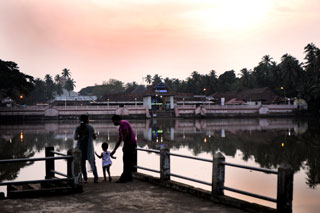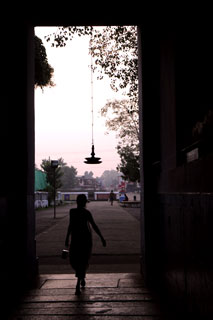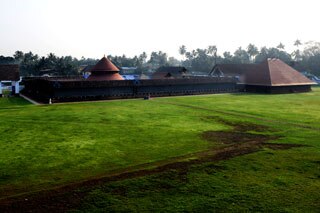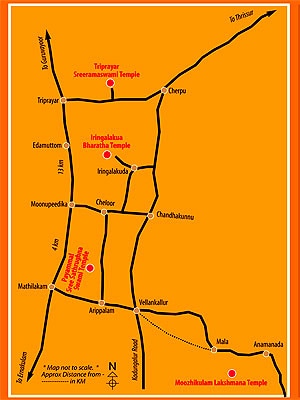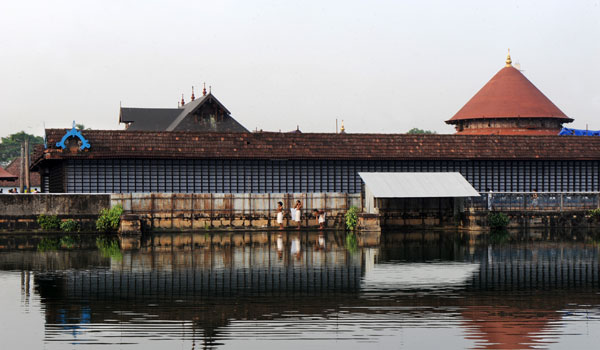Triprayar Sree Rama Swami Temple

Triprayarappan
Triprayar Temple, located in Thrissur district is one of the important temples dedicated to Lord Rama. Triprayar temple is located 22 kms south west of Thrissur in between Kodungalloor and Guruvayoor in the mid landmass of Chettuva. The temple is situated on the bank of river Theevra. Theevra river is also called Purayar. Hence this place got the name Thirupurayar (sacred river) and later became Triprayar. There is an interesting legend about the origin of this river. Lord Mahavishnu during his Vamana incarnation visited this place while going to
Thrikkakkara and he found no water to wash his legs as the whole place was dry and desolate. Vamana took the water from his kamandalu (a small round vessel used by hindu sages to carry water) and poured the water to wash his legs, that source of water never went dry but kept on flowing as the Thiru Purayar or the Thriprayar (river of divine source) as it is called now. Purayar is also called Nandiyar.

Out of the four idols discovered by fisher men, the Sree Rama idol was the most important. Vakkayil Kaimal decided to install it in Triprayar. It is said that when the image of Rama was discovered and was about to be consecrated, it was divinely ordained that a peacock would appear and mark the exact time for installation. Kaimal and his men waited for a long time for the peacock but it didn't appeared. Apparently the Tanthri (chief priest) installed the idol when a devotee bearing peacock feathers appeared. Soon after the installation the peacock appeared in front of the Sreekovil. It is said that the priests and Kaimal regretted their decision later and to make up for this deficiency the sacrificial stone or the valiya balikkallu was installed at the spot marked by the peacock. Hence the balikkal is said to have the same importance as the deity itself. But this sacrificial stone showed a tendency to spin on its axis. It was
Naranathu Bhranthan who fixed it at the spot by hammering a nail through it amidst the chanting of mantras. A mark of a nail can still be seen gives credence to this belief.

In order to prevent any decline in the power of the idol on account of the change in its location Naranathu Bhranthan also arranged to install two goddesses on either side of the deity-Sree Devi on the right and Bhumi Devi on the left. Another legend says that it was Vilwamangalm Swamiyar who is associated with several temples of Kerala, installed the Sree Devi and Bhumi Devi images and shut the Western doors of the temple. One day Swamiyar reached this temple and offered prayers to Lord Rama. During his pooja he noticed that Sree Devi and Bhumi Devi were entering the temple from the western gateway to offer prayers to the Lord. In order to set right the fault in location of the idol he requested them to stay inside the sreekovil. The Goddesses agreed and later Swamiyar installed Sree Devi and Bhumi Devi idols on either side of Rama. He then closed the western doors and left the temple. The western doors of the temple remain shut even today.
The image of Rama (Triprayar Thevar) resembles the Chaturbhuja Vishnu form with four arms, bearing a conch(Panchajanya), a disc (Sudarsana), a bow (Kodanda) and a garland respectively. It is believed that the deity worshipped here possesses some of the aspects of Shiva too. It was after killing the asura, Khara that Sri Rama got both the Shaiva and Vaishnava aspects. Thus Triprayar Thevar is also called Khara Samhara Moorthy. It is also believed that the portrayal of Rama with a garland held in the image's hand is also suggestive of aspects of Bhrahma and hence the deity is said to be a manifestation of the Trimoorthis. The image is adorned with necklaces and other fine jewelry. Images of Sreedevi and Bhudevi are on either side. There is an image of Dakshinamoorthy, in the sanctum facing the south. Dakshinamoorthy is commonly found in Shiva temples. There is also a lamp behind the image which is kept burning all the time. Because of these and also because of the fact that people got relief when troubled by evil spirits chathan-the deity is believed to have a Shiva aspect also.

Ganapathy prathishta is located at the south west corner of the sreekovil. Though there is no separate idol for Rama's best devotee Hanuman, it is believed that his presence is always there at the Namaskara mandapam of the temple. Devotees generally bow before the mandapa imagining the presence of Hanuman there before worshipping Sree Rama. The offering of flattened rice (avil) made from dried paddy is meant for Hanuman. Near the main temple towards the north there is a small shrine of Gosala Krishna. Outside the temple in the southern side of the courtyard there is an Ayyappa (Shastha) shrine. It is believed that the Shastha shrine was located originally at the site corresponding to the temple's sreekovil. With the arrival of Sree Rama, Ayyappa moved to the south in the present location. Now Thriprayar Thevar is the presiding deity of the Arattupuzha Pooram, one of the important festivals of central Kerala. Lord Ayyappa of this temple also participated in this pooram before the installation of Lord Rama. Except Triprayar Thevar, all other participants in this pooram are Sasthas and Bhagavathys of different temples. This also points to the conversion of Shastha shrine to Rama shrine.
The temple opens at 3am in the morning and remains open till 12pm. The temple reopens at 4pm and remains open till 8.30pm. There are five poojas conducted here as in all great temples- usha pooja, ethirtha pooja, panthiradi pooja, ucha pooja and athazha poojaa. There are three sheevelis (a processional image of the deity is carried around the temple). For Ucha sheeveli elephents are not used for procession. In Mandalakkalam (November-December) there will be a Kazcha Sheeveli instead of Ucha sheeveli. Nirmalya darshan (early morning when the sanctum opens for the day) and athazha pooja are considered very sacred. For athazha pooja especially devas and rishis are supposed to be present to have darshan of the Lord. The original idol of Rama was subject to evere wear with the passage of time. Astrological investigations however revealed that the Lord did not desire to have change of the vigraha. Therefore a raiment was made in Panchaloha and the same now covers the original stone image.
Ekadasi in Vrischikam (November- December) and pooram in Meenam (March-April) are the two annual festivals conducted in the temple.
The Ekadasi festival in the month of Vrischikam(November - December) is the main festival. Ekadasi celebrations start on Dasami day(day before Ekadasi) itself when Ayyappa is taken in procession. This shows the importance of Ayyappa whose temple it was before the installation of Sri Rama. On Ekadasi day, Sree Rama is taken in procession with as many as 21 elephants participating. Thousands of people from far and near will gather here to witness the celebrations.
Thriprayar Thevar is the presiding deity of the
Arattupuzha Pooram. The seven day Pooram festival is celebrated in the malayala month of Meenam(March-April). The Pooram festival begins on the Makayiram asterism in Meenam and ends on the Pooram asterism. During the 7 days the real show of festival is only on the first and last days. There is no flag-hoisting ceremony here and in fact there is no flag-staff to herald the annual utsavam. That means the festival is not Dwajadi but is Padahadi. The procession from the temple begins after 101 Kathina Vedi and Kottippurappadu. This is famous as Makayiram Purappadu. Every day for seven days the procession starts from Triprayar for a certain place where the arattu is held, giving opportunity to thousands outside Triprayar to offer worship to the deity. On the day of Arattupuzha pooram, Triparayarappan goes there in order to participate in the pooram. It is believed that to witness the 'Deva Mela' all the gods and goddesses in addition to spirits and fairies present themselves at Arattupuzha. This Pooram is a mega event and attending it will do away the sins of a whole year, it is believed. The entire route, stretching 12-km, of Sree Rama from Triprayar to Aratupuzha get make-up by the villagers and wait thousands in excitement to see the deity passes through in the night. The full stretch of the route is also thrilled by fireworks from one end to the other end. On Pooram day the famous Koottiezhunnalliippu will be performed and Triprayar Thevar will be accompanied by Goddesses Oorakathamma and Cherppu Bhagavathy on either side. These Goddesses represents Sree Devi and Bhumi Devi respectively. In the past according to the Hindu mythology, 108 gods and goddesses participate at the pooram. In the old palm-leaf records there are certain references which tell us that the pooram festival was started even before 583 B.C. Over a hundred elephants took part until a generation ago. Now the number of elephants has come down. But there is no diminution in the rituals or in the pageantry.
The best way to escape from the clutches of the frolicsome spirit is to worship Thriprayarappan and please him with the offerings. The name itself of the strong of the temple is known as Chathan Bhandaram. It is a common sight that people afflicted with spirits perform various kinds of offerings at the temple to get them eradicated from their bodies.



Firing of kathinas or Vedi vazhipadu is an important offering here. It is to commemorate the return of Hanuman after the search of Sita, with the words, 'Drishta Sita'-seen Sita. There is a belief among Hindus that if anyone sets apart some money as an offering to the deity for firing crackers, the delivery of a pregnant woman in his family will be easy and comfortable. Besides Palpayasam, Chandanam Charthu(smearing of the idol with sandal paste), different archanas and meenoottu(feeding fishs in theevra river) are other important offerings to the deity.
The performing art Chakyar Koothu is very much associated with this temple and is an important offering here. It is said that the once king Samoothiri visited this temple and watched this art and he expressed his wish to see the Hanuman’s mischieves in Lanka in detail. Thus the Koothu was extended to a twelve day performance. The Koothu performance starts on the first of Vrichika month(November). To stage Koothu there should be at least one Brahmin present in the audience. Once there was no Brahmin at all available and the Chakiyar, the performer of Koothu, did not know how to proceed. He stood perplexed, not knowing what to do. Suddenly a voice came from the sanctum saying that 'Koothu is not for Brahmins but for me. Therefore perform Koothu in my presence.' Since then Koothu, which was, being staged in the specially erected Koothambalam on the south-east corner of the temple started being staged in the mandapa itself inside the temple. And only angya Koothu(pantomime) is performed and the sanctum remains open throughout the performance. From Vrischikam 1 (mid-November) kuttu is presented for 12 days by the temple management itself. The subject enacted is Anguliyangam in the Ramayana, that is, Hanuman taking the ring from Site after finding her in Lanka and taking it back to Sri Rama. The major Part of the performance is devoted to a conversation between Hanuman and Sita.
Triprayar temple is rich in wood carvings. The sreekovil is circular in shape with a copper covered conical roof and is surmounted by a golden Thazhikakkudam. The circular sanctum has several sculptural representations of scenes from the Ramayana with a dynamic and lively vitality of design and form a lavish decoration and an integral part of the architectural edifice of the temple. Its walls are decorated with beautiful mural paintings. The namaskara mandapa, which is copper-plated, is profusely sculptured -having 24 panels of woodcarvings representing navagrahas.
The Triprayar temple was originally under the domain of the Zamorin rulers of Kerala. It later came under the posession of the Dutch, the Mysore sultans and the rulers of Cochin. Triprayar temple is situated in what is called Chettuva Island, which was formerly under the Zamorins. In 1719 it was annexed by the Dutch. Then Tipu Sultan defeated the Dutch and annexed the territory. Tipu Sultan did not spare Triprayar Thevar also. To test the divinity of the idol he struck at one of the hands. Blood started oozing. He repented his action and developed faith and devotion to the god. To make amends he donated to the temple some of the landed property he had annexed. Later the territory became part of Cochi and the Cochi King gave the ownership of this temple to local Nampoothiri community. Thereafter this temple was owned by three important Nampoothiri families - Jyanappally, Chelur, and Punnappilli - and the administration was carried out by Blahayil Nair. But unfortunately due to continuous conflict between the owners and Blahayil Nair, the government took over the charge of the temple. Now it is under the administrative control of the Cochin Devaswom Board.











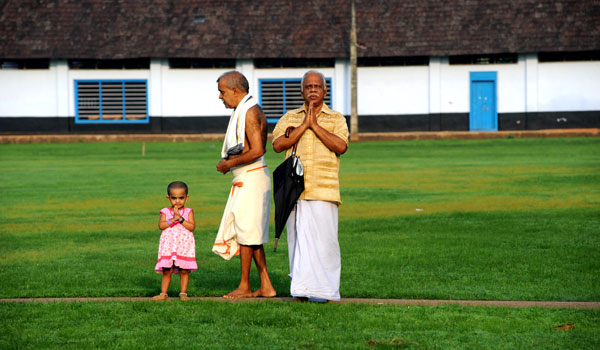

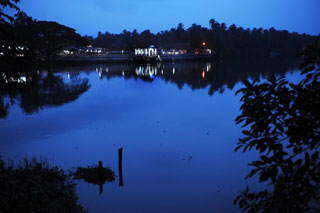
 അമ്പലമുണരുമ്പോഴേക്കും പരിസരവും ഉണര്ന്നു തുടങ്ങുന്നു. തൊട്ടുമുന്നിലൂടൊഴുകുന്ന പുഴയില് വലിയ മത്സ്യങ്ങളെ കാണാം. ഇവ മീനുട്ട് നിവേദ്യം ഭുജിക്കാനായി തേവരുടെ നടയില് ഒത്തുകൂടുന്നു. ക്ഷേത്രത്തിന്റെ തെക്കുപടിഞ്ഞാറെ മൂലയില് ഗണപതി പ്രതിഷ്ഠയുണ്ട്. വടക്കേനടയില് ഗോശാലകൃഷ്ണനും തെക്കേനടയില് അയ്യപ്പ പ്രതിഷ്ഠയും. സര്വ്വലോകനാഥനും സര്വ്വരോഗ നിവാരണനും സര്വ്വ വിദ്യാനാഥനുമായ ദക്ഷിണാമൂര്ത്തിയുടെ സാന്നിധ്യവും ശ്രീകോവിലിനെ ധന്യമാക്കുന്നു. കൊടികയറി ഉത്സവം നടക്കാത്ത അപൂര്വക്ഷേത്രമാണ് ഇത്. പ്രസിദ്ധമായ ആറാട്ട് പുഴ പൂരത്തിന്റെ നായകത്വം വഹിക്കുന്നത് തൃപ്രയാറപ്പനാണ്. ബാധാ ഉപദ്രവങ്ങളില്നിന്ന് മുക്തി സിദ്ധിക്കുന്നതിന് തൃപ്രയാറപ്പനെ ഉപാസിക്കുന്നത് ഉത്തമാണെന്നാണ് വിശ്വാസം. തൊഴുതു വലംവെച്ച് മീനൂട്ടും നടത്തി ഭരത ക്ഷേത്രത്തിലേക്ക് യാത്രയാവാം.
അമ്പലമുണരുമ്പോഴേക്കും പരിസരവും ഉണര്ന്നു തുടങ്ങുന്നു. തൊട്ടുമുന്നിലൂടൊഴുകുന്ന പുഴയില് വലിയ മത്സ്യങ്ങളെ കാണാം. ഇവ മീനുട്ട് നിവേദ്യം ഭുജിക്കാനായി തേവരുടെ നടയില് ഒത്തുകൂടുന്നു. ക്ഷേത്രത്തിന്റെ തെക്കുപടിഞ്ഞാറെ മൂലയില് ഗണപതി പ്രതിഷ്ഠയുണ്ട്. വടക്കേനടയില് ഗോശാലകൃഷ്ണനും തെക്കേനടയില് അയ്യപ്പ പ്രതിഷ്ഠയും. സര്വ്വലോകനാഥനും സര്വ്വരോഗ നിവാരണനും സര്വ്വ വിദ്യാനാഥനുമായ ദക്ഷിണാമൂര്ത്തിയുടെ സാന്നിധ്യവും ശ്രീകോവിലിനെ ധന്യമാക്കുന്നു. കൊടികയറി ഉത്സവം നടക്കാത്ത അപൂര്വക്ഷേത്രമാണ് ഇത്. പ്രസിദ്ധമായ ആറാട്ട് പുഴ പൂരത്തിന്റെ നായകത്വം വഹിക്കുന്നത് തൃപ്രയാറപ്പനാണ്. ബാധാ ഉപദ്രവങ്ങളില്നിന്ന് മുക്തി സിദ്ധിക്കുന്നതിന് തൃപ്രയാറപ്പനെ ഉപാസിക്കുന്നത് ഉത്തമാണെന്നാണ് വിശ്വാസം. തൊഴുതു വലംവെച്ച് മീനൂട്ടും നടത്തി ഭരത ക്ഷേത്രത്തിലേക്ക് യാത്രയാവാം.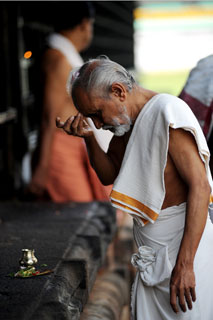
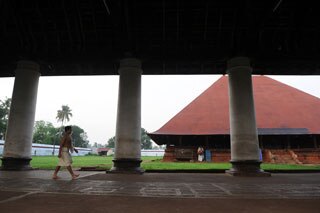 വനവാസത്തിനുപോയ ശ്രീരാമന് മടങ്ങിവരുന്നതും കാത്ത് തപസ്സനുഷ്ഠിക്കുന്ന ഭരതനാണ് ഇവിടുത്തെ പ്രധാന പ്രതിഷ്ഠ. അതുകൊണ്ട് വൈഷ്ണവ ക്ഷേത്രമാണെങ്കിലും ശിവക്ഷേത്രത്തില് എന്നപോലെയുള്ള പ്രദക്ഷിണരീതിയാണ് ഈ ക്ഷേത്രത്തില് ചെയ്യുന്നത്. ഉപദേവതാ പ്രതിഷ്ഠ ഇല്ല. വിഗ്രഹത്തില് കണ്ട മാണിക്യകാന്തി പരീക്ഷിക്കുന്നതിനായി കായംകുളം രാജധാനിയില്നിന്നും കൊണ്ടുവന്ന മാണിക്യം വിഗ്രഹത്തിനടുത്തുവെച്ച് നോക്കിയെന്നും ആ മാണിക്യം വിഗ്രഹത്തില് ലയിച്ചുചേര്ന്നു എന്നുമാണ് ഐതിഹ്യം. ഇതിനുശേഷമാണ് കൂടല്മാണിക്യം എന്ന പേരുണ്ടായത്. ഈ ക്ഷേത്രത്തില് പൂജയ്ക്ക് കര്പ്പൂരം, ചന്ദനത്തിരി എന്നിവ ഉപയോഗിക്കാറില്ല. കൂടാതെ ദീപാരാധനയും പതിവില്ല. കൂടല്മാണിക്യം ഭരതസ്വാമി സന്താനദായകനും രോഗശാന്തിയെ പ്രദാനം ചെയ്യുന്നവനുമാണ്. ആണ്കുട്ടിയുണ്ടാകുന്നതിന് കടുംപായസവും പെണ്കുട്ടിയുണ്ടാകുന്നതിന് വെള്ള നിവേദ്യവും ക്ഷേത്രത്തില് വഴിപാടായി നടത്തുന്നു. വയറുവേദനയ്ക്ക് വഴുതനങ്ങ നിവേദ്യവും അര്ശസ്സിന് നെയ്യാടിസേവയും ശ്വാസകോശ സംബന്ധമായ രോഗങ്ങള്ക്ക് മീനൂട്ടും ഈ ക്ഷേത്രത്തിലെ സവിശേഷ വഴിപാടുകളാണ്. ക്ഷേത്രത്തിലെ പുത്തരി നിവേദ്യത്തിന്റെ ഭാഗമായ മുക്കിടി നിവേദ്യം സേവിച്ചാല് ഒരു വര്ഷം യാതൊരു രോഗവും ഉണ്ടാകില്ലെന്നും വിശ്വാസം.
വനവാസത്തിനുപോയ ശ്രീരാമന് മടങ്ങിവരുന്നതും കാത്ത് തപസ്സനുഷ്ഠിക്കുന്ന ഭരതനാണ് ഇവിടുത്തെ പ്രധാന പ്രതിഷ്ഠ. അതുകൊണ്ട് വൈഷ്ണവ ക്ഷേത്രമാണെങ്കിലും ശിവക്ഷേത്രത്തില് എന്നപോലെയുള്ള പ്രദക്ഷിണരീതിയാണ് ഈ ക്ഷേത്രത്തില് ചെയ്യുന്നത്. ഉപദേവതാ പ്രതിഷ്ഠ ഇല്ല. വിഗ്രഹത്തില് കണ്ട മാണിക്യകാന്തി പരീക്ഷിക്കുന്നതിനായി കായംകുളം രാജധാനിയില്നിന്നും കൊണ്ടുവന്ന മാണിക്യം വിഗ്രഹത്തിനടുത്തുവെച്ച് നോക്കിയെന്നും ആ മാണിക്യം വിഗ്രഹത്തില് ലയിച്ചുചേര്ന്നു എന്നുമാണ് ഐതിഹ്യം. ഇതിനുശേഷമാണ് കൂടല്മാണിക്യം എന്ന പേരുണ്ടായത്. ഈ ക്ഷേത്രത്തില് പൂജയ്ക്ക് കര്പ്പൂരം, ചന്ദനത്തിരി എന്നിവ ഉപയോഗിക്കാറില്ല. കൂടാതെ ദീപാരാധനയും പതിവില്ല. കൂടല്മാണിക്യം ഭരതസ്വാമി സന്താനദായകനും രോഗശാന്തിയെ പ്രദാനം ചെയ്യുന്നവനുമാണ്. ആണ്കുട്ടിയുണ്ടാകുന്നതിന് കടുംപായസവും പെണ്കുട്ടിയുണ്ടാകുന്നതിന് വെള്ള നിവേദ്യവും ക്ഷേത്രത്തില് വഴിപാടായി നടത്തുന്നു. വയറുവേദനയ്ക്ക് വഴുതനങ്ങ നിവേദ്യവും അര്ശസ്സിന് നെയ്യാടിസേവയും ശ്വാസകോശ സംബന്ധമായ രോഗങ്ങള്ക്ക് മീനൂട്ടും ഈ ക്ഷേത്രത്തിലെ സവിശേഷ വഴിപാടുകളാണ്. ക്ഷേത്രത്തിലെ പുത്തരി നിവേദ്യത്തിന്റെ ഭാഗമായ മുക്കിടി നിവേദ്യം സേവിച്ചാല് ഒരു വര്ഷം യാതൊരു രോഗവും ഉണ്ടാകില്ലെന്നും വിശ്വാസം.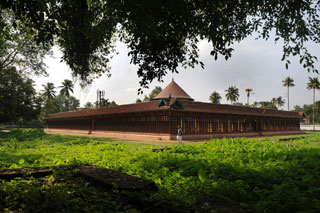
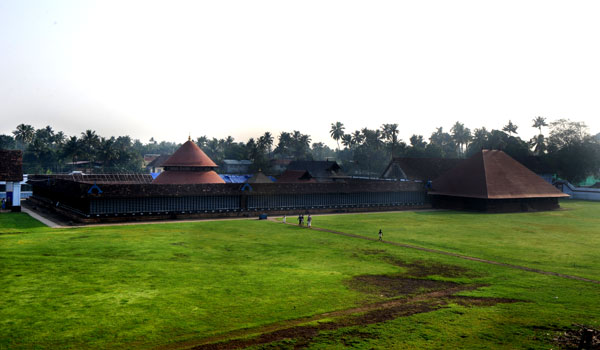
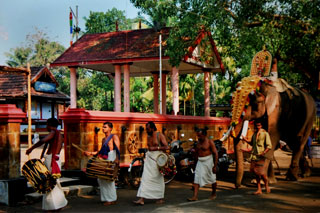
 കരിങ്കല്ലില് കൊത്തിയെടുത്ത ശ്രീകോവില് ചതുരാകൃതിയിലാണ്. ശ്രീകോവിലില് ശാന്തസ്വരൂപിയായ ശത്രുഘ്നസ്വാമി മാത്രം. ശംഖ ചക്ര ഗദാപത്മങ്ങളില്ലാത്ത ചതുര്ബാഹുവിഗ്രഹം. ശ്രീകോവിലിന് തെക്കുപടിഞ്ഞാറ് ദക്ഷിണാഭിമുഖമായി ഗണപതി ഭഗവാനും. മുഖമണ്ഡപത്തില് ആഞ്ജനേയ സാന്നിധ്യമുണ്ട്. ഈ ക്ഷേത്രത്തിലെ ഏറ്റവും പ്രധാനപ്പെട്ട വഴിപാടാണ് സുദര്ശന പുഷ്പാഞ്ജലി. സുദര്ശനചക്ര സമര്പ്പണവും പ്രധാനമാണ്. ആഭിചാരദോഷം, ശത്രുദോഷം, ബാധാദോഷം എന്നിവയില്നിന്നും മുക്തി സിദ്ധിക്കുന്നതിനായി ഈ ക്ഷേത്രത്തില് ദര്ശനം നടത്തുന്നത് ഉത്തമമാണെന്ന് കരുതപ്പെടുന്നു.
കരിങ്കല്ലില് കൊത്തിയെടുത്ത ശ്രീകോവില് ചതുരാകൃതിയിലാണ്. ശ്രീകോവിലില് ശാന്തസ്വരൂപിയായ ശത്രുഘ്നസ്വാമി മാത്രം. ശംഖ ചക്ര ഗദാപത്മങ്ങളില്ലാത്ത ചതുര്ബാഹുവിഗ്രഹം. ശ്രീകോവിലിന് തെക്കുപടിഞ്ഞാറ് ദക്ഷിണാഭിമുഖമായി ഗണപതി ഭഗവാനും. മുഖമണ്ഡപത്തില് ആഞ്ജനേയ സാന്നിധ്യമുണ്ട്. ഈ ക്ഷേത്രത്തിലെ ഏറ്റവും പ്രധാനപ്പെട്ട വഴിപാടാണ് സുദര്ശന പുഷ്പാഞ്ജലി. സുദര്ശനചക്ര സമര്പ്പണവും പ്രധാനമാണ്. ആഭിചാരദോഷം, ശത്രുദോഷം, ബാധാദോഷം എന്നിവയില്നിന്നും മുക്തി സിദ്ധിക്കുന്നതിനായി ഈ ക്ഷേത്രത്തില് ദര്ശനം നടത്തുന്നത് ഉത്തമമാണെന്ന് കരുതപ്പെടുന്നു.